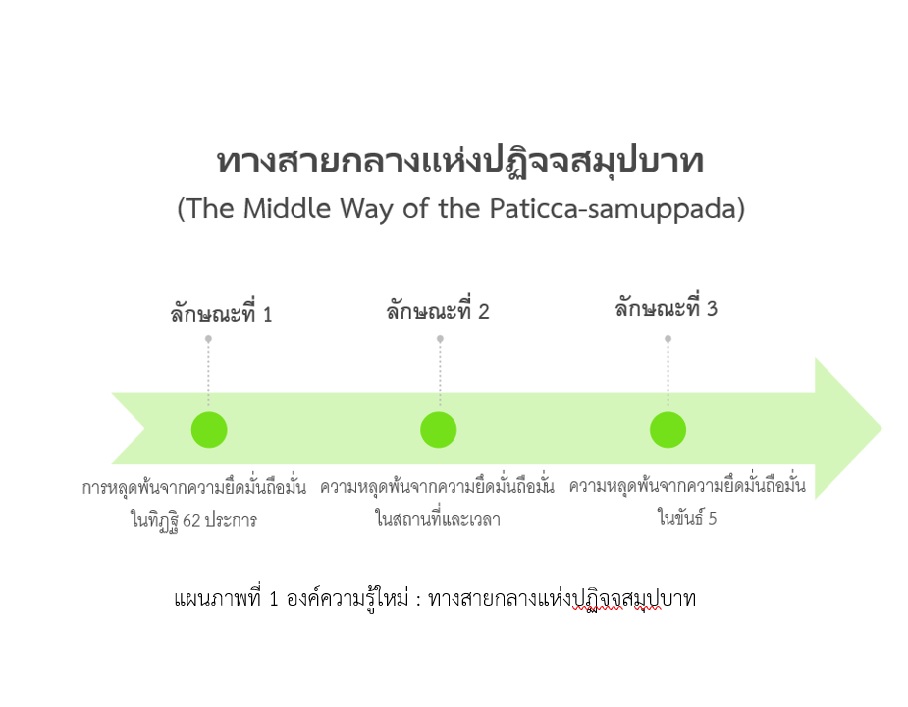The Middle Way of the Paticca-samuppada
Keywords:
Paticca-samuppada, Middle WayAbstract
This academic article aims to study and analyze to find the answer to what the Middle Way of Paticca-samuppada The study finds that Paticca-samuppada is an attribute attainable only by Lord Buddha to its fullest extent, which is considered a special characteristic of the Paticca-samuppada. Even though individuals at the level of disciples may have insight into this doctrine, they do so to a limited degree, not as deeply as Lord Buddha. From the analysis of the “Middle Way of Paticca-samuppada”, it can be summarized that liberation from attachment to firm beliefs involves three aspects: 1) Liberation from attachment to supreme views, namely liberation from extreme views. This includes liberation from views of eternalism and annihilationism, which can be expanded to liberation from attachment to 62 kinds of views. 2) Liberation from attachment to places and times, including liberation from attachment to certain realms in existence and attachment to views about the past, future, and present and 3) Liberation from attachment to groups, including liberation from attachment to forms, rituals, agreements, social affiliations, and spirits.
References
การศาสนา, กรม. (2525). พระไตรปิฎกภาษาไทย ฉบับหลวง. กรุงเทพฯ : กรมการศาสนา.
จำนงค์ ทองประเสริฐ. (2556). บทความพิเศษ ปฏิจจสมุปบาท. วารสารพุทธศาสน์ศึกษา จุฬาลงกรณ์มหาวิทยาลัย, 20(1), 75-98.
เทพพร มังธานี. (2564). อิทัปปัจจยตาทางจริยศาสตร์. วารสารปณิธาน, 17(1), 119-142.
ธนสิทธิ์ ฉัตรสุวรรณ. (2560). การศึกษาวิเคราะห์แนวคิดเรื่องภพในพระพุทธศาสนาเถรวาท. วารสารบัณฑิตศึกษาปริทรรศน์, 13(1), 1-11.
ธเนศ เกษศิลป์. (2561). วิถีทางสายกลาง เพื่อความอยู่ร่วมกันของสังคมและลดการเบียดเบียนธรรมชาติแบบบูรณาการ. วารสารปรัชญาปริทรรศน์, 23(1), 82-91.
พระธรรมปิฎก (ป.อ. ปยุตฺโต). (2545). พจนานุกรมพุทธศาสตร์ฉบับประมวลธรรม. (พิมพ์ครั้งที่ 10).กรุงเทพฯ : สหธรรมิก.
พระสาทิพย์ อนาลโย, พระปลัดสมชาย ปโยโค และพระมหาขวัญชัย กิตฺติเมธี. (2562). การวิเคราะห์ความสัมพันธ์ระหว่างปฏิจจสมุปบาทกับการบรรลุธรรม. วารสาร มจร พุทธปัญญาปริทรรศน์, 4(2), 225-236.
พุทธทาสภิกขุ. (2540). ทาน ศีล ภาวนา. กรุงเทพฯ : สํานักพิมพสุขภาพใจ.
________. (2548). ธรรมะในฐานะวิทยาศาสตร์. (พิมพ์ครั้งที่ 2). สุราษฎร์ธานี : ธรรมทานมูลนิธิ.
มหาจุฬาลงกรณราชวิทยาลัย. (2506). พระไตรปิฎกภาษาบาลี ฉบับมหาจุฬา เตปิฏกํ 2500. กรุงเทพมหานคร : โรงพิมพ์รุ่งเรืองธรรม.
________. (2539). ปปญฺจสูทนี มชฺฌิมปณฺณาสกอฏฺกถาปาลิ. กรุงเทพฯ : มหาจุฬาลงกรณราชวิทยาลัย.
________. (2539). พระไตรปิฎกภาษาไทย ฉบับมหาจุฬาลงกรณราชวิทยาลัย. กรุงเทพฯ : โรงพิมพ์มหาจุฬาลงกรณราชวิทยาลัย.
________. (2539). ลีนตฺถปฺปกาสนี มหาวคฺคฏีกา. กรุงเทพฯ : มหาจุฬาลงกรณราชวิทยาลัย.
________. (2539). วิสุทฺธิมคฺคปาลิ. กรุงเทพฯ : มหาจุฬาลงกรณราชวิทยาลัย.
________. (2539). สมฺโมหวิโนทนีอฏ̣กถาปาลิ. กรุงเทพฯ : มหาจุฬาลงกรณราชวิทยาลัย.
มหามกุฏราชวิทยาลัย. (2539). ธมฺมปทฏ̣กถาปาลิ. กรุงเทพฯ : มหามกุฏราชวิทยาลัย.

Downloads
Published
How to Cite
Issue
Section
License

This work is licensed under a Creative Commons Attribution-NonCommercial-NoDerivatives 4.0 International License.


